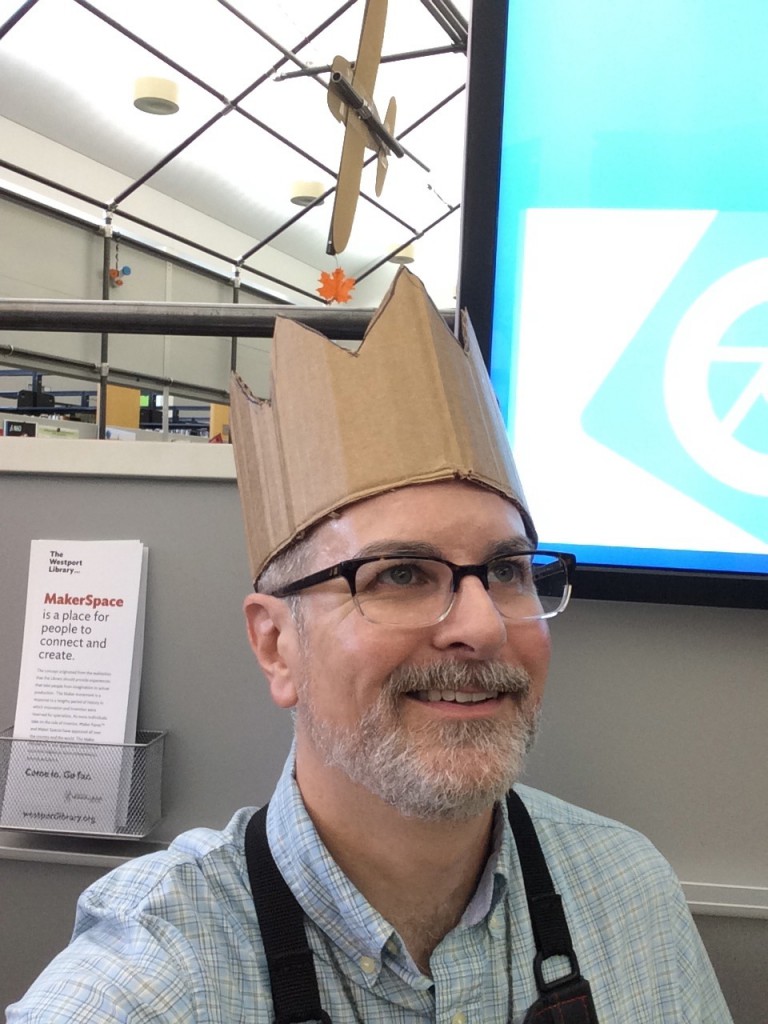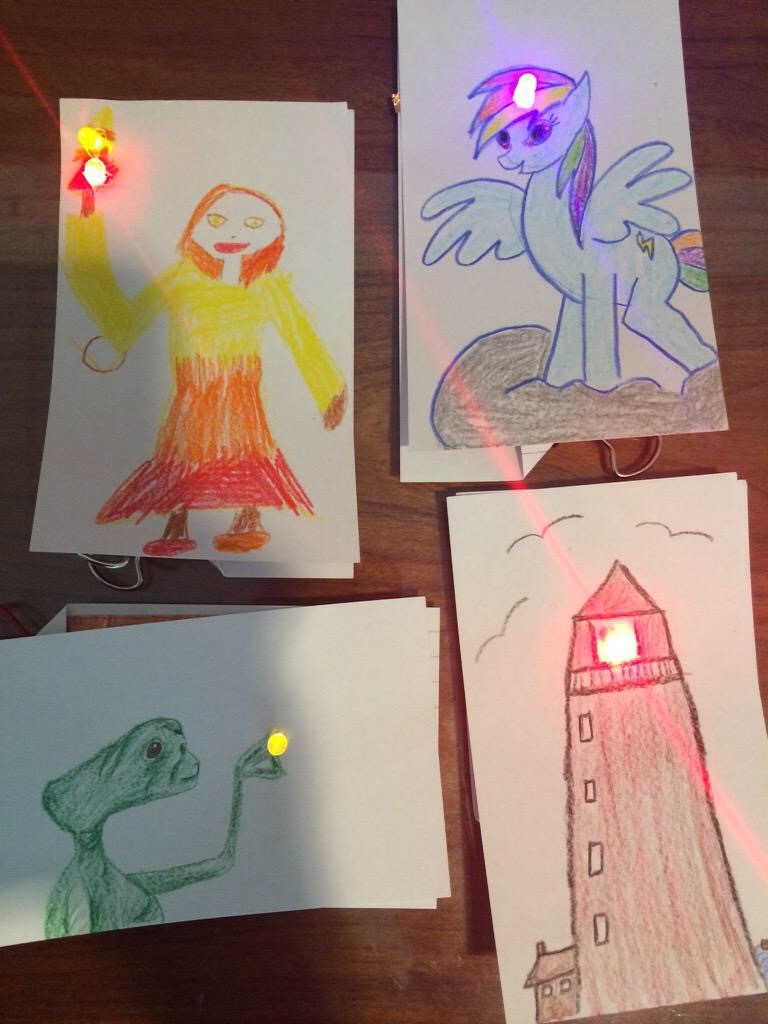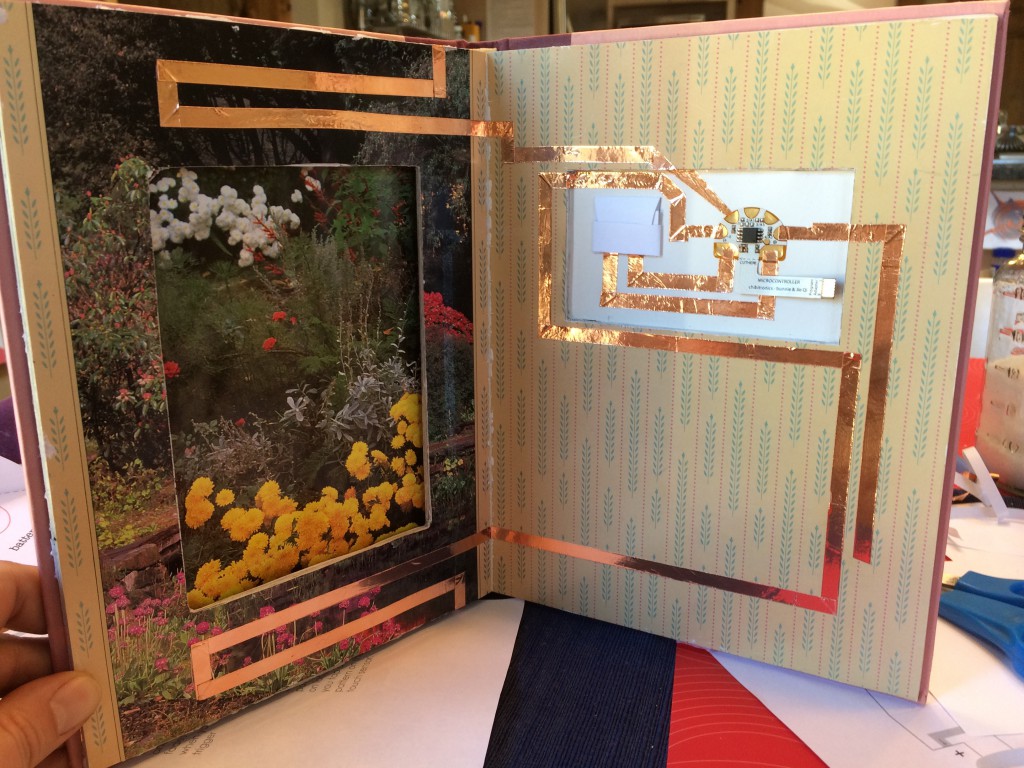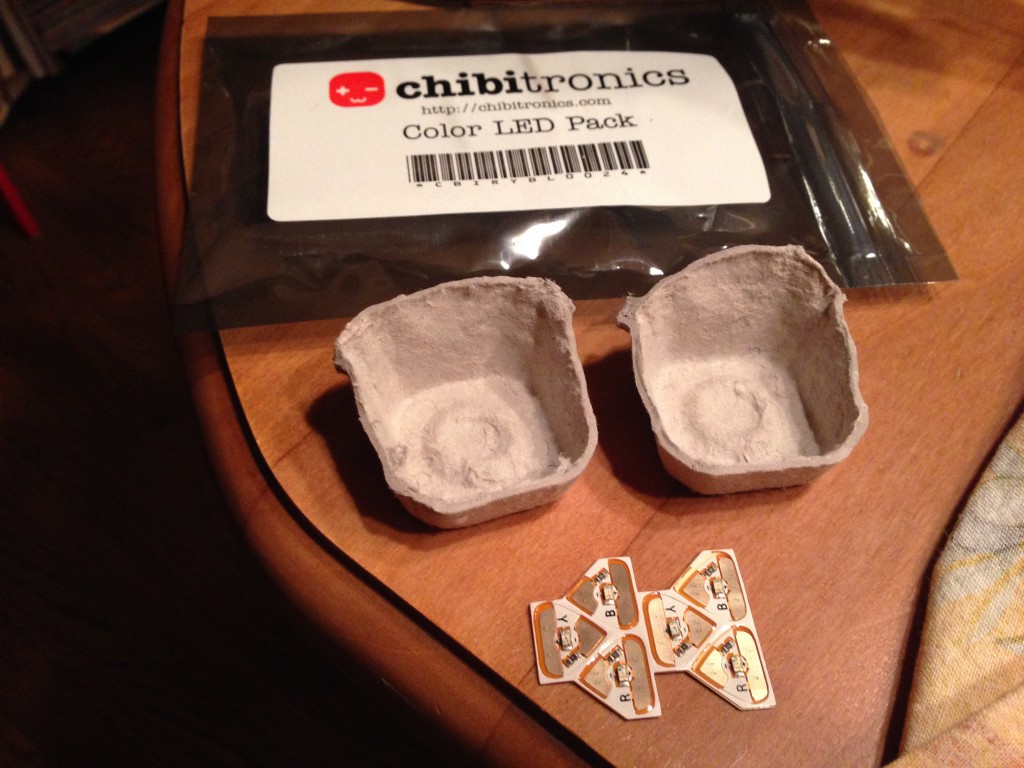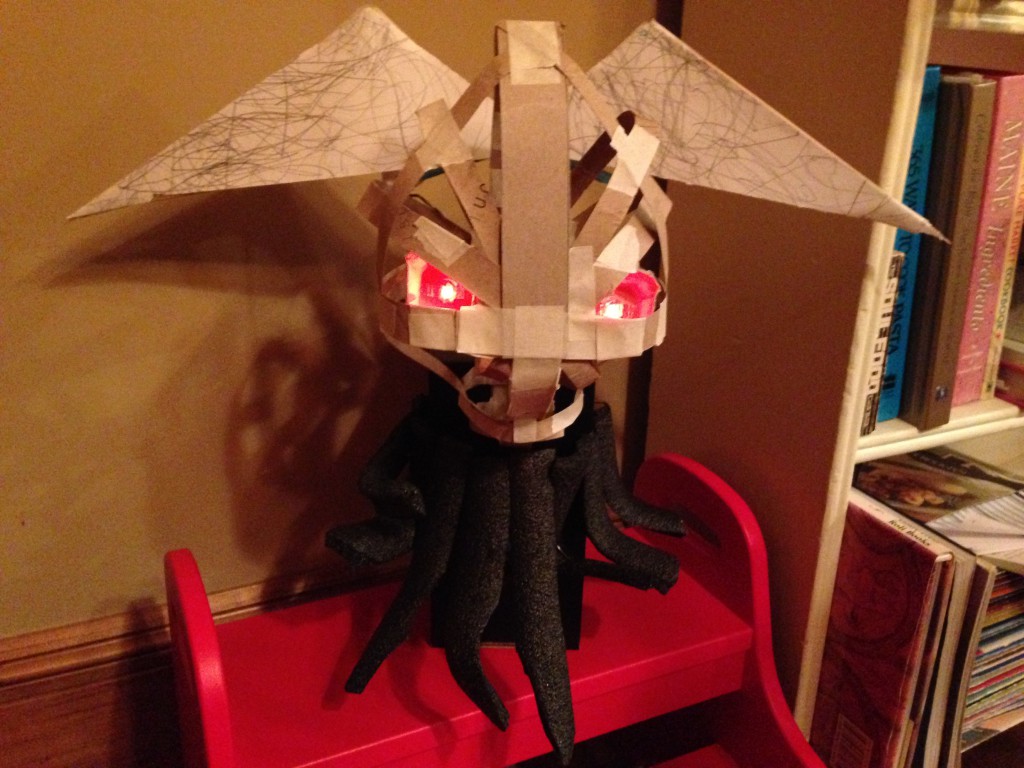1. What is your story?
I am a constructionist educator, author, digital artist, amateur programmer, husband and father, and curmudgeon. I enjoy exploring the spaces where crafting and technology intersect.
I worked in schools as a Technology Specialist, Technology Club founder and advisor, an “Academic Technology Coordinator,” teacher, and systems engineer for seventeen years working with teachers and students from preKindergarten through high school. Nowadays I am finishing my second book for Constructing
Modern Knowledge Press: it is a whimsical introduction to HyperDuino, an Arduino shield that eliminates the need to breadboard or to know too terribly much about electronics and allows you creative freedom to integrate microcontroller technology into some delightfully crafty projects. I also facilitate an after school club for middle school students at a charter school in Bridgeport, CT, teaching them programming, fabrication, and 3D design and printing through the lens of Logo. I facilitate a young makers workshop at a public library and I am leading Horizon National’s implementation of a LEGO Foundation grant to integrate LEGO, programming, play, and STEAM into their curriculum. I run an education consulting company,
Imagination Heavy Industries.
As a father of a four year old I also get to reexperience many ideas and concepts for the first time with my son. I really enjoy building wooden blocks and LEGO with him, exposing him to a variety of different music, and encouraging him to express himself through a variety of mediums. It might seem weird that somebody who uses technology so fluently and daily has a kid who uses technology in ways that are meaningful to him but very limited. My son does not really understand how to use an iPad because we never have parked him behind one like we see many parents do. But he does have a One Laptop Per Child laptop that he really enjoys “typing” on, which is good for letter recognition and hand/eye coordination, and using to make music. Lately he has been using an old Macintosh and MacPaint to make some fantastic drawings. For each their own, but I think technology oftentimes is used as a pacifier and encourages passive consumption from an early age and that is unfortunate in my mind.
2. What are the things you like to make?
The things that I make fall into two categories: things that I make that I hope other people can make by following my lead and documentation and things that I make that I have no intention of other people duplicating.
As a maker and educator I feel very strongly that a big part of the maker process should include documenting what you work on, how you accomplish the project, and sharing your instructions so other people can iterate on or remix your work. Many of my projects are created to use in workshops or other learning situations, so I dream up projects that other people would find whimsical and worth putting
time and effort into building. These projects play with the ideas of crafting, like
using familiar, on hand items that are easy to work with but open ended enough to encourage creative construction. The technology is another ingredient in the project, one that makes “magic” like sound, light, or movement happen. These projects play a little with the idea of the unexpected, like when you are able to build something with cardboard that ends up being quite high tech.
The other projects are more personal and are intended to help me better understand a technology or concept, to decorate my home or that of my family and friends, or to spread an idea. A great example of one of these projects is the Cthulhu automaton that I built. It uses Chibitronics LEDs as its
eyes!
I like to make things that involve Logo programming and creating art through programming; 3D design, 3D scanning, and 3D printing; LEGO; strange sounds and noises that some people find annoying; programming and using light; and revisiting lowtech approaches and themes.
3. What is your current project?
Typically I have several projects going at the same time!
For the past few months my work has been focused on HyperDuino and crafting whimsical projects to house microcontroller outputs and sensors as I wrote my second book. The book is now in the editing stages so I am winding down that work.
I recently finished an interactive book project around the Chibitronics microcontroller sticker. I used the “replay” pin to build a scene of fireflies in a forest. This was the first time I used the Chibitronics micocontroller sticker and it exemplified the “magical” technology I love to use in my projects because of its simplicity of use and its powerful effects. You can see more of it
here.
Right now much of my focus has been on a couple different Logo projects. First, the LogoTurtle that I helped Brian Silverman and Eric Nauman develop. This is a project that revisits the Logo floor turtle of the 1970s and brings it into the current age. It uses an Adafruit Metro Mini microcontroller, stepper motors, a servo, and 3D printed parts. It is an amazing STEAM project for the classroom, makerspace, or home. It allows you to explore some pretty important math concepts in artistic ways. Lately, I have been exploring the meaning of angles and arcs with the middle school Logo students.
Another big project I am working on is LightLogo, also by Brian Silverman. This version of Logo allows you to program light using a Metro Mini or Uno and a 24 LED NeoPixel ring. A few of my Young Maker Club students have become adept at programming complex patterns of light in a few short lines of Logo code. We are now exploring housing the NeoPixel ring and optics, lenses, and projecting the light.
Finally, I am using a “hacked” version of Scratch 1.4 that allows me to control two LEGO motors (here). I am building a LEGO player piano that allows the user to compose music using bands of color. The sprite controls a physical piano as it moves across the bands of color. It is a whimsical and weird project.
4. How would you describe your creative making process?
My projects tend to reflect my abilities of working with a particular material or materials at a point in time. Oftentimes, the impetus to start a project comes from wanting to learn a new skill, work with a new (to me) technology, or work with a new material. Some projects start with a sketch, but other projects just come from my mind and thinking something through for a couple of days.
After I decide to make or program or build or craft something, I typically move my materials into one place so I am not disrupted trying to track down parts once I start working. I usually have in my mind a path or process that I am going to take.
If the project is something I hope to teach others, I use my iPhone to take photos of each step, even if the steps end up taking me into a dead end. I try not to rush my work and am typically able to put down the work and resume later when I find the time. Some projects become a bit obsessive for me and I will wait until the work week when my wife and son are at work and school and spend the entire day on a single project or problem that I am trying to solve.
As the project progresses and I become more familiar with whatever about the project is new to me, I start to make the changes necessary to achieve whatever vision I originally had when I conceived the project. Sometimes a material does not work the way I expect it to, or I make a serendipitous discovery along the way that changes how I am going to accomplish something. The willingness to abandon a path and take a new one, I think, is an important milestone in the growth of a maker, because it leads you to understand and value iteration, knowing your limitations or the limitations of whatever materials you chose, and makes for a stronger, more polished product in the end. I always consider that I can revisit a topic or theme as my skills progress.
In the end I try to write up a post about the project and post it on my blog,
http://joshburker.blogspot.com. Since I am making more of my living lately writing, I do not post as many step-by-step recipes as I used to because I have to sell those! Instead, I try to discuss the big ideas behind a project, or my observations of how I or students work through a particular problem, topic, or workshop.
5. What inspires your making?
All sorts of things! Since I do a lot of Logo programming, the geometry in the world is a big inspiration for me. I try to observe how shapes, lines, planes, arcs, and other shapes intersect, interact, and combine in the world around me, whether intentionally or organically, and use those shapes as inspiration for some of my Logo programming and designs.
Also, the maker community that I have on Twitter is a big inspiration: right now, for example, I am collaborating with a few amazing people who I have never met in real life on LEGO art bots, linkages, gear trains, and different unexpected ways to push or pull a pen around on paper. It is really awesome for me to be able to put out an idea that I am working on and see how other people pick it up, turn it over, and remix it.
6. What helpful hints do you have for future makers?
Document your work! Not only does documenting your work through photographs, video, written reflections, or other means allow you and others to see your creative process, it helps others to build upon your work, remix it, and make something new from it.
Don’t be afraid of dead ends. Following an idea to its conclusion even when it ends up not working is a powerful learning experience because it helps you better identify the right tool for the right time.
Share your work at all steps of the process. Use Twitter to show other people what you are working on, to get advice, or to look for the accolades and admiration you don’t get at home or work because nobody understands exactly what it is you do.
7. What is your favorite thing about Chibitronics?
I love Chibitronics because they lower the threshold to creativity. Chibitronics LED stickers are my goto for teaching people about simple circuitry, constructing paper switches and circuits, and easily integrating lights into their projects. Now that I have experience with the microcontroller sticker I am hyping it to anyone who listens to me! It opens so many interesting creative doors. I appreciate Chibitronics challenges me to keep some of my projects low tech but pushes me to expand on the projects: collaged light up circuitry is something I started playing with last fall and have in turn inspired others to try as well. Just like Chibitronics stickers make it simple to craft interactive circuitry, collaging eliminates people’s self-perceived failing that they are unable to draw. Combining paper circuitry and collaging is great fun: try it!
We really enjoyed talking with Josh. If you’d like more information about Josh, please visit his blog. You can also preorder his upcoming book at his publisher’s website.

